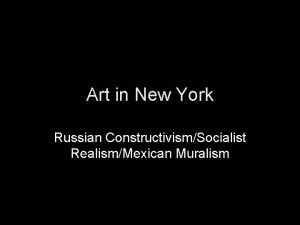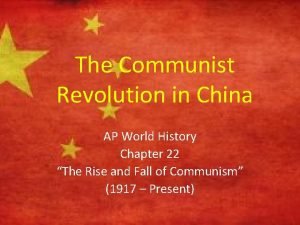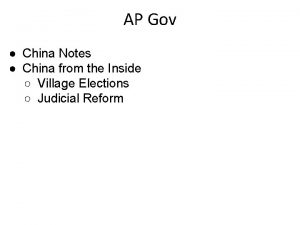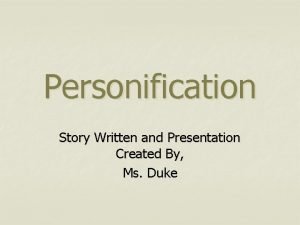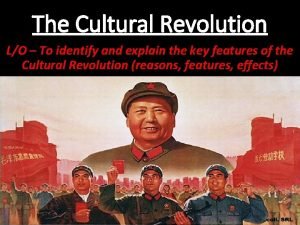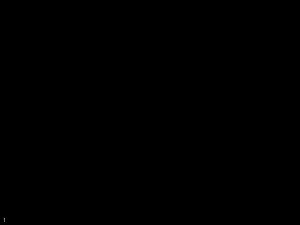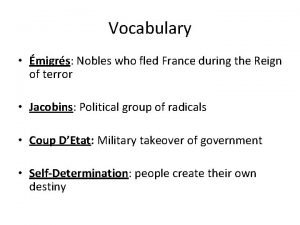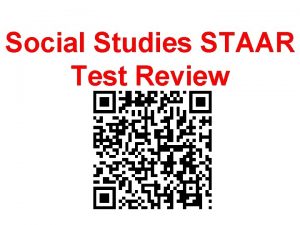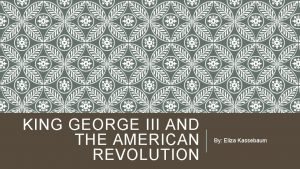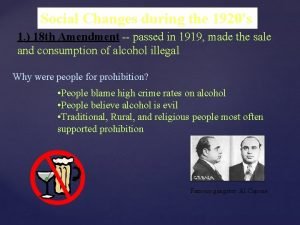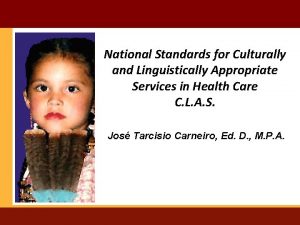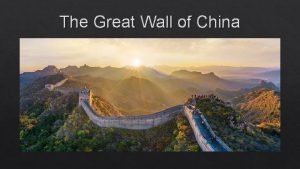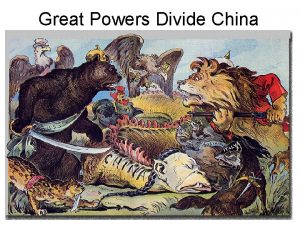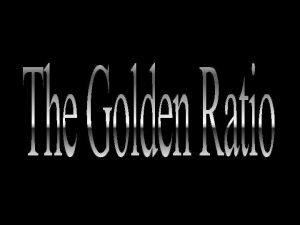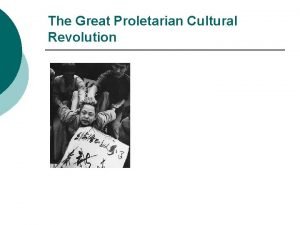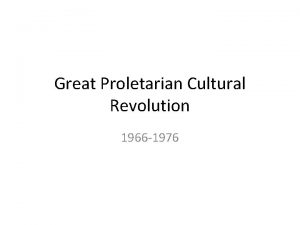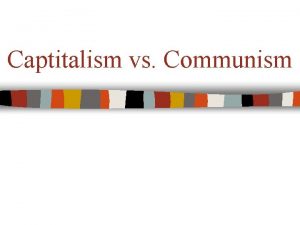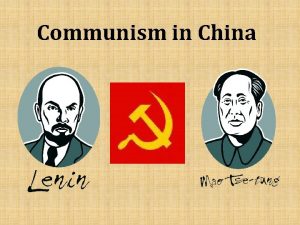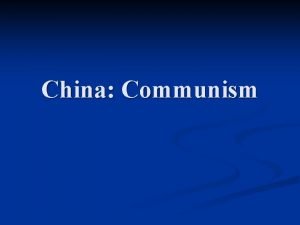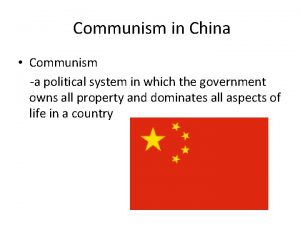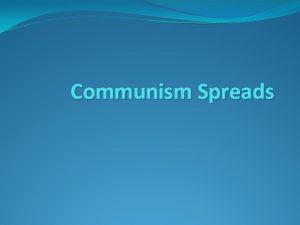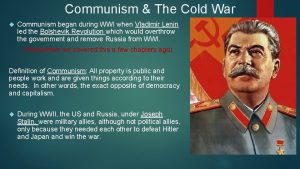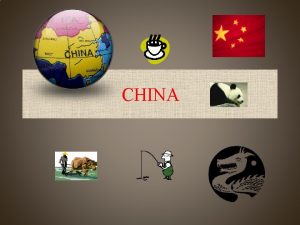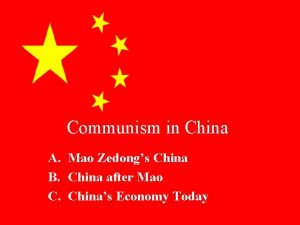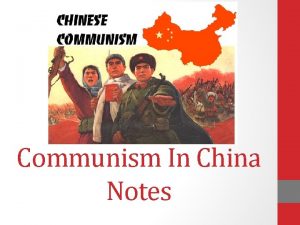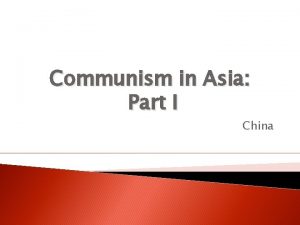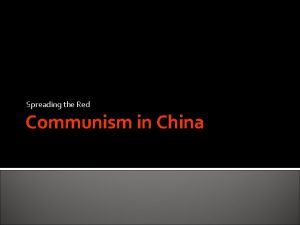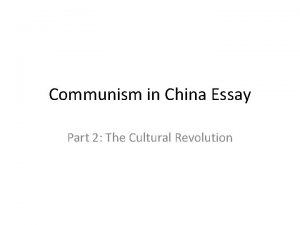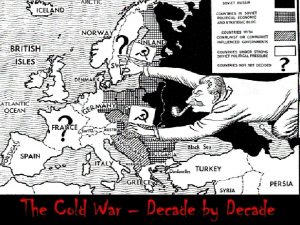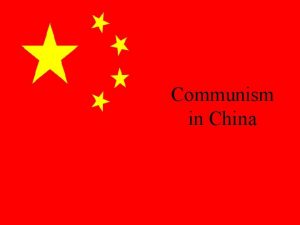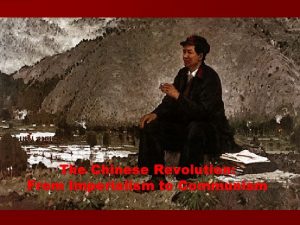China during the Great Proletarian Cultural Revolution Communism























- Slides: 23

China during the Great Proletarian Cultural Revolution

Communism In China In the mid-1930 s, China was politically unstable after centuries of being ruled by dynasties, in which the same family ruled for generations. Throughout this period, a tiny and elite landlord class ruled over the masses of poor peasants. The Chinese Communist Party formed with the idea of allowing the poor peasants to move up in society. On October 1, 1949, Chairman Mao Zedong proclaimed the founding of the People’s Republic of China.

Hold on… What is Communism?

What is Communism? This is the symbol of Communism: the Hammer and the Sickle Hammer for the Workers Sickle for the Peasants – the farm labourers You might be thinking, Who are these guys?

What is Communism? Karl Marx and Frederick Engels wrote The Communist Manifesto in 1847. It’s a short book, but billions of people have read it. This is Karl Marx, the “Father of Communism. ” People who believe in his ideas are called “Marxists. ” This is his good friend, Frederick Engels.

What is Communism? • Marx and Engels studied the history of the world’s economies. • This means the way that power, industry and finance are controlled. • They saw the way countries developed in stages. Communism Socialism Capitalism Feudalism Primitive Communism You might be thinking, Explain these please!

What is Communism? Primitive Communism This is how humans first lived together – in small tribes. Primitive means “not very advanced, ” e. g. hunting and gathering. Communism means that everything was shared amongst the tribe – food, jobs, belongings. No one owned land. Eventually a group comes to power, which leads to Feudalism…

What is Communism? Under feudalism, a king, emperor, or chief becomes the ruler over all the people. Feudalism Primitive Communism The people are kept uneducated and told that God chose the king to rule. The church helps the king this way. He gives land privileges to “nobles” who rule the people for him. As trade develops, some people get richer. This leads to Capitalism…. .

What is Communism? The business owners or capitalists get richer while the workers do all the hard work. The capitalists get more power to serve their own interests. Feudalism Capitalism creates a huge workingclass of people who soon get angry at the way they are treated. They organize in unions and demand changes. This will lead to a revolution and Socialism…

What is Communism? The workers take control of the country to produce things for everyone. Because nothing is made for profit, all people benefit from education and healthcare. Socialism Capitalism In the Socialist revolution, all the rulers (kings, churches, capitalists) are gotten rid of. These ideas spread across the world to create Communism….

What is Communism? The remaining capitalists put up a bitter fight, but the will of the people will always win. Communism Socialism As everyone now works together, war is a thing of the past; armies are not needed. Sharing means no police are needed. Everything is provided by the people, so money becomes a thing of the past. All human activity goes towards benefiting each other and allowing all to live their lives to the fullest.

Timeframe The Great Proletarian Cultural Revolution began on May 16, 1966. Led by Mao Zedong, it lasted until 1976, although Mao himself declared that it was over in 1969.

Location China is located in East Asia and borders the Yellow Sea, the East China Sea, Mongolia, India, and many other nations. The Chinese consider Taiwan to be part of China and call it the Republic of China.

A New Culture The Cultural Revolution was just that: a change in the Chinese culture. However, this revolution was government sponsored, as Mao sought to eliminate bourgeoisie* intellectuals from China, and create a powerful, single-class, proletariat** country. *Bourgeoisie: the capitalist class who own most of society’s wealth and means of production. **Proletariat: Workers or the working class.

Re-teach Intellectuals Instead of killing the intellectuals in China, who amounted to less than 10% of the population, Mao decided to reeducate intellectuals in the ways of the proletariat. To do so, he made many books and learning sources illegal and relocated members of the bourgeoisie class to farming communities where they were forced to do manual labor.

Re-teach Intellectuals

Literature During the Cultural Revolution, almost all forms of creative literature were made illegal. All western books were banned and destroyed, and no one was able to publish any literature unless it supported the Communist National Party. Mao Zedong published many works himself, and almost everyone in China was forced to carry around a book of his quotations known as the “Little Red Book. ”

Music, like all other forms of art, only existed in the form of propaganda. Typical songs were titled “The East is Red, ” “Long Live Chairman Mao, ” and “I Love Beijing's Tiananmen. ” Below are the lyrics to the song entitled “I am a Little Member of the Commune. ” I am a little member of the commune, with a little sickle in my hand, and a bamboo basket on my shoulder. I go to work after class, cutting weeds, collecting manure, and picking up the lost wheat ears. The more I work, the more I love it. Ayh-hey, Aye-hey, Always keeping in mind the good character of the poor-and-lower-middle peasants, Loving the collective and loving labor, I am a little member of the commune!

Art At one point in China’s history, calligraphy had been considered the greatest form of art, above painting and dancing. The Chinese language consists of 60007000 characters, each with an intricate design. During the Cultural Revolution, all forms of art, calligraphy, painting, dancing, and singing, were reduced to those that supported the Communist National Party. “Let the new Socialist Performing Arts conquer every stage. ”

Etiquette Three Main Rules of Discipline are as follows: (1) Obey orders in all your actions. (2) Do not take a single needle piece of thread from the masses. (3) Turn in everything captured.

Religion Mao lashed out at organized religion in China. He blamed religion for China’s problems, and under his rule many different types of temples and churches were burned to the ground or converted into government buildings. However, some people began to worship Mao, and Mao worship evolved into a cult activity.

People Over 90% of all of the people in China belonged to the proletariat class. These were countryside farmers who lived in small farming communities. People would farm for both sustenance and local sales, and sometimes meat was hard to come by in certain locations.

Women Before Mao, women had been treated as subservient in China. However, Mao insisted on treating women as equals, saying “Women hold up half the sky. ” “Proletarian revolutionary rebels unite!”
 Proletarian mother
Proletarian mother Cultural revolution definition ap world history
Cultural revolution definition ap world history Russian revolution vs french revolution
Russian revolution vs french revolution You should hope that this game will be over soon
You should hope that this game will be over soon Third agricultural revolution definition
Third agricultural revolution definition Cultural genocide china
Cultural genocide china The china danced on the shelves during the earthquake
The china danced on the shelves during the earthquake The snow whispered as it fell to the ground
The snow whispered as it fell to the ground Young mao
Young mao Cultural revolution
Cultural revolution Cultural revolution
Cultural revolution Nobles who fled france during the revolution
Nobles who fled france during the revolution Wentworth cheswell
Wentworth cheswell Who was the king during the american revolution
Who was the king during the american revolution Ads during the industrial revolution
Ads during the industrial revolution Capitalism def
Capitalism def Social changes in the 1920s
Social changes in the 1920s Cultural competence staircase
Cultural competence staircase How long ago was the great wall of china built
How long ago was the great wall of china built Great wall of china golden ratio
Great wall of china golden ratio Chinese dragon political cartoon
Chinese dragon political cartoon Great wall of china golden ratio
Great wall of china golden ratio Territorial morphology definition
Territorial morphology definition Great wall of china golden ratio
Great wall of china golden ratio
